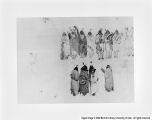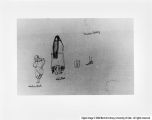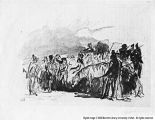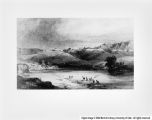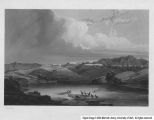| OCR Text |
Show 41 all of the figures in the sketches were used and only the musicians were modified to any extent.16 With the completion of this inner circle of dancers, Vogel may have begun to fill in the composition with the background figures. Lightly etched in aquatint, these figures, both standing and mounted on horseback, fill out the composition, allowing the central dancers to be placed in context of the ceremony as a whole. Although certain references found in Bodmer's portfolio can be traced in the development of these figures, none of these Indians duplicate any of the original sketches. This is because the background figures were intended simply as that-background filler. As such, they do not add or subtract from the reportive validity of the event reproduced in aquatint. However, it is the third component of Tableau 27--those foreground figures at the outer edges of the circle-that has caused the majority of problems for historians and ethnologists. It is obvious these figures were introduced into the composition without reference to the original sketches of the ceremony. Five Indians, three Minnetarees and two Mandans, stand in the foreground of Tableau 27, as observers to the dance.^ Reproduced from portraits made during Bodmer's stay at Fort Clark, these figures were perhaps introduced into the composition because the image suffered from a lack of depth that the background figures could not completely remedy. These five portrait figures are reproduced from Bodmer's portfolio with great accuracy and detail. Nonetheless, because they are reproduced directly from the portraits, several of them retain a static quality of formal pose. This quality is greatly modified, however, by the skilled placement of the figures, some reproduced in reverse, to achieve more natural groupings. |
















































